Impact of High Staff Turnover on Hospitality Management Practices
VerifiedAdded on 2023/01/07
|13
|4065
|61
Report
AI Summary
This research proposal investigates the significant issue of high employee turnover within the hospitality industry, specifically using Hilton Hotels as a case study. The research aims to identify the primary causes of this turnover, such as working conditions, lack of growth opportunities, and management practices, and to evaluate their impact on hotel management. The study will explore challenges like operational disruptions and increased training costs, and propose strategies to mitigate these issues, including improved employee engagement, better training programs, and enhanced management support. The literature review will analyze existing research on turnover causes, management impacts, and potential solutions, providing a comprehensive understanding of the topic. The methodology will include a detailed description of the research approach, data collection methods, and ethical considerations to ensure a robust and reliable investigation.
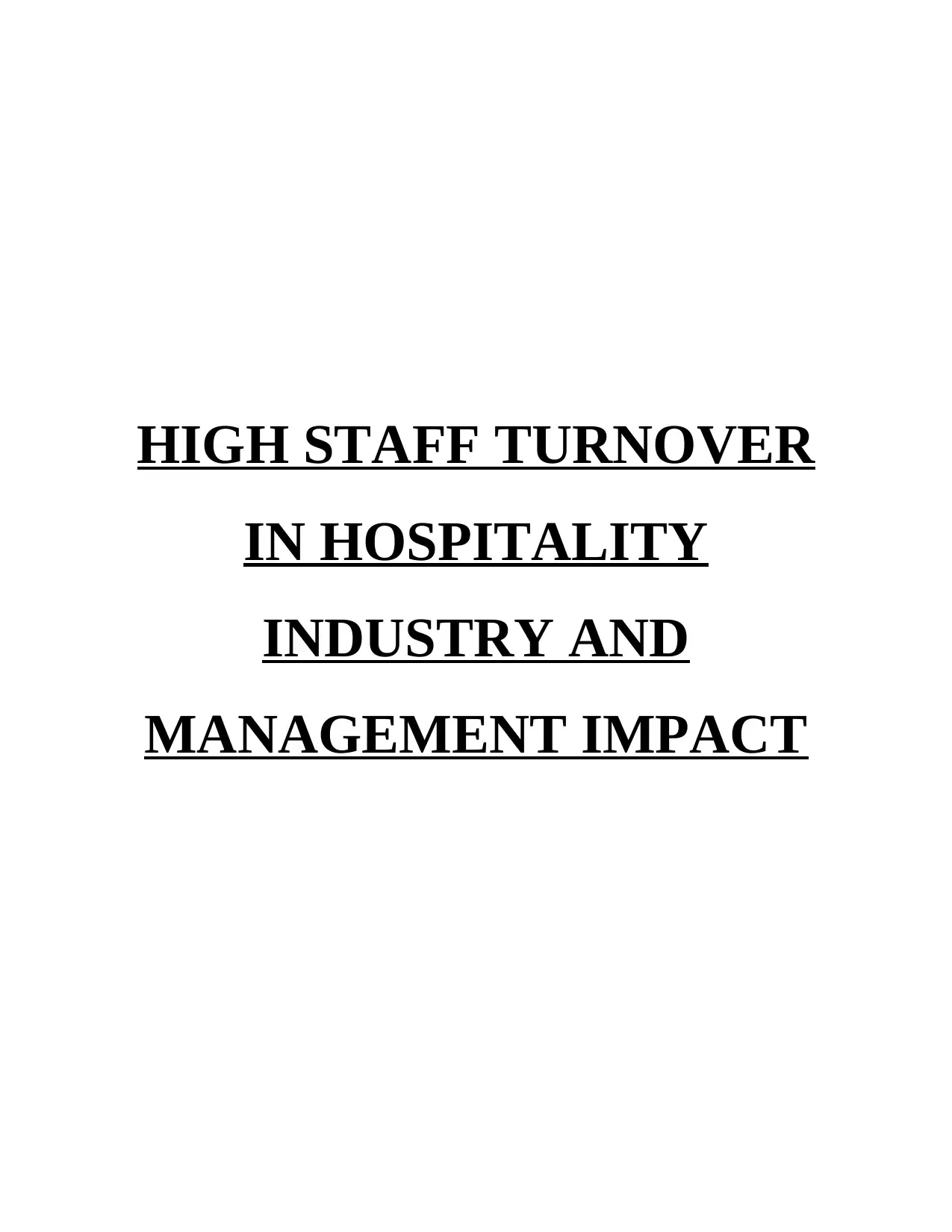
HIGH STAFF TURNOVER
IN HOSPITALITY
INDUSTRY AND
MANAGEMENT IMPACT
IN HOSPITALITY
INDUSTRY AND
MANAGEMENT IMPACT
Paraphrase This Document
Need a fresh take? Get an instant paraphrase of this document with our AI Paraphraser

TABLE OF CONTENTS
INTRODUCTION...........................................................................................................................3
MAIN BODY..................................................................................................................................3
THEORETCIAL BACKGROUND AND RESEARCH FOCUS...................................................3
Aim..............................................................................................................................................3
Objective......................................................................................................................................3
Research Questions......................................................................................................................4
Literature Review........................................................................................................................4
JUSTIFICATION AND CONTEXTUALIZATION......................................................................6
METHODOLOGY..........................................................................................................................8
Research Methodology................................................................................................................8
Access and Ethics......................................................................................................................10
Research Limitations.................................................................................................................10
REFERENCES..............................................................................................................................11
INTRODUCTION...........................................................................................................................3
MAIN BODY..................................................................................................................................3
THEORETCIAL BACKGROUND AND RESEARCH FOCUS...................................................3
Aim..............................................................................................................................................3
Objective......................................................................................................................................3
Research Questions......................................................................................................................4
Literature Review........................................................................................................................4
JUSTIFICATION AND CONTEXTUALIZATION......................................................................6
METHODOLOGY..........................................................................................................................8
Research Methodology................................................................................................................8
Access and Ethics......................................................................................................................10
Research Limitations.................................................................................................................10
REFERENCES..............................................................................................................................11
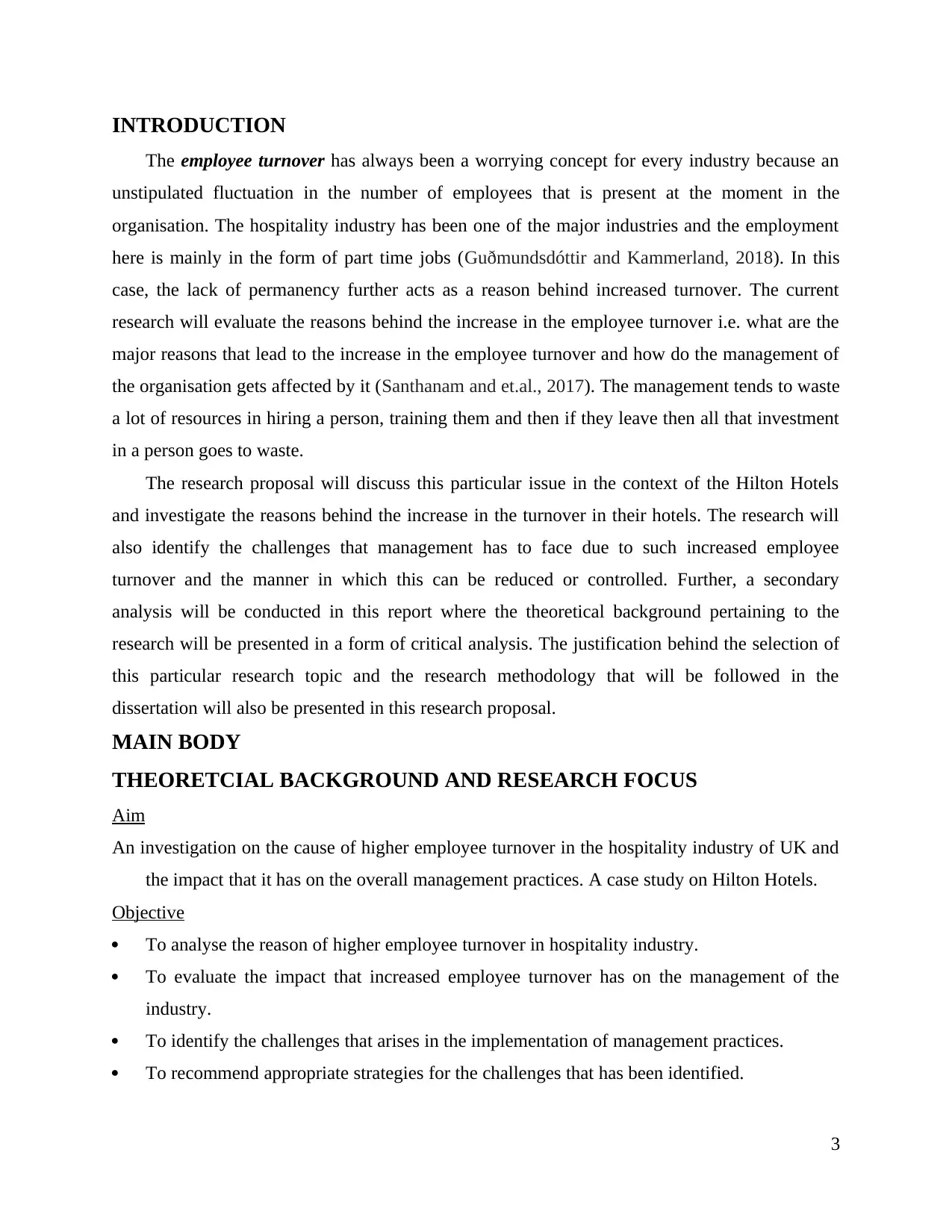
INTRODUCTION
The employee turnover has always been a worrying concept for every industry because an
unstipulated fluctuation in the number of employees that is present at the moment in the
organisation. The hospitality industry has been one of the major industries and the employment
here is mainly in the form of part time jobs (Guðmundsdóttir and Kammerland, 2018). In this
case, the lack of permanency further acts as a reason behind increased turnover. The current
research will evaluate the reasons behind the increase in the employee turnover i.e. what are the
major reasons that lead to the increase in the employee turnover and how do the management of
the organisation gets affected by it (Santhanam and et.al., 2017). The management tends to waste
a lot of resources in hiring a person, training them and then if they leave then all that investment
in a person goes to waste.
The research proposal will discuss this particular issue in the context of the Hilton Hotels
and investigate the reasons behind the increase in the turnover in their hotels. The research will
also identify the challenges that management has to face due to such increased employee
turnover and the manner in which this can be reduced or controlled. Further, a secondary
analysis will be conducted in this report where the theoretical background pertaining to the
research will be presented in a form of critical analysis. The justification behind the selection of
this particular research topic and the research methodology that will be followed in the
dissertation will also be presented in this research proposal.
MAIN BODY
THEORETCIAL BACKGROUND AND RESEARCH FOCUS
Aim
An investigation on the cause of higher employee turnover in the hospitality industry of UK and
the impact that it has on the overall management practices. A case study on Hilton Hotels.
Objective
To analyse the reason of higher employee turnover in hospitality industry.
To evaluate the impact that increased employee turnover has on the management of the
industry.
To identify the challenges that arises in the implementation of management practices.
To recommend appropriate strategies for the challenges that has been identified.
3
The employee turnover has always been a worrying concept for every industry because an
unstipulated fluctuation in the number of employees that is present at the moment in the
organisation. The hospitality industry has been one of the major industries and the employment
here is mainly in the form of part time jobs (Guðmundsdóttir and Kammerland, 2018). In this
case, the lack of permanency further acts as a reason behind increased turnover. The current
research will evaluate the reasons behind the increase in the employee turnover i.e. what are the
major reasons that lead to the increase in the employee turnover and how do the management of
the organisation gets affected by it (Santhanam and et.al., 2017). The management tends to waste
a lot of resources in hiring a person, training them and then if they leave then all that investment
in a person goes to waste.
The research proposal will discuss this particular issue in the context of the Hilton Hotels
and investigate the reasons behind the increase in the turnover in their hotels. The research will
also identify the challenges that management has to face due to such increased employee
turnover and the manner in which this can be reduced or controlled. Further, a secondary
analysis will be conducted in this report where the theoretical background pertaining to the
research will be presented in a form of critical analysis. The justification behind the selection of
this particular research topic and the research methodology that will be followed in the
dissertation will also be presented in this research proposal.
MAIN BODY
THEORETCIAL BACKGROUND AND RESEARCH FOCUS
Aim
An investigation on the cause of higher employee turnover in the hospitality industry of UK and
the impact that it has on the overall management practices. A case study on Hilton Hotels.
Objective
To analyse the reason of higher employee turnover in hospitality industry.
To evaluate the impact that increased employee turnover has on the management of the
industry.
To identify the challenges that arises in the implementation of management practices.
To recommend appropriate strategies for the challenges that has been identified.
3
⊘ This is a preview!⊘
Do you want full access?
Subscribe today to unlock all pages.

Trusted by 1+ million students worldwide
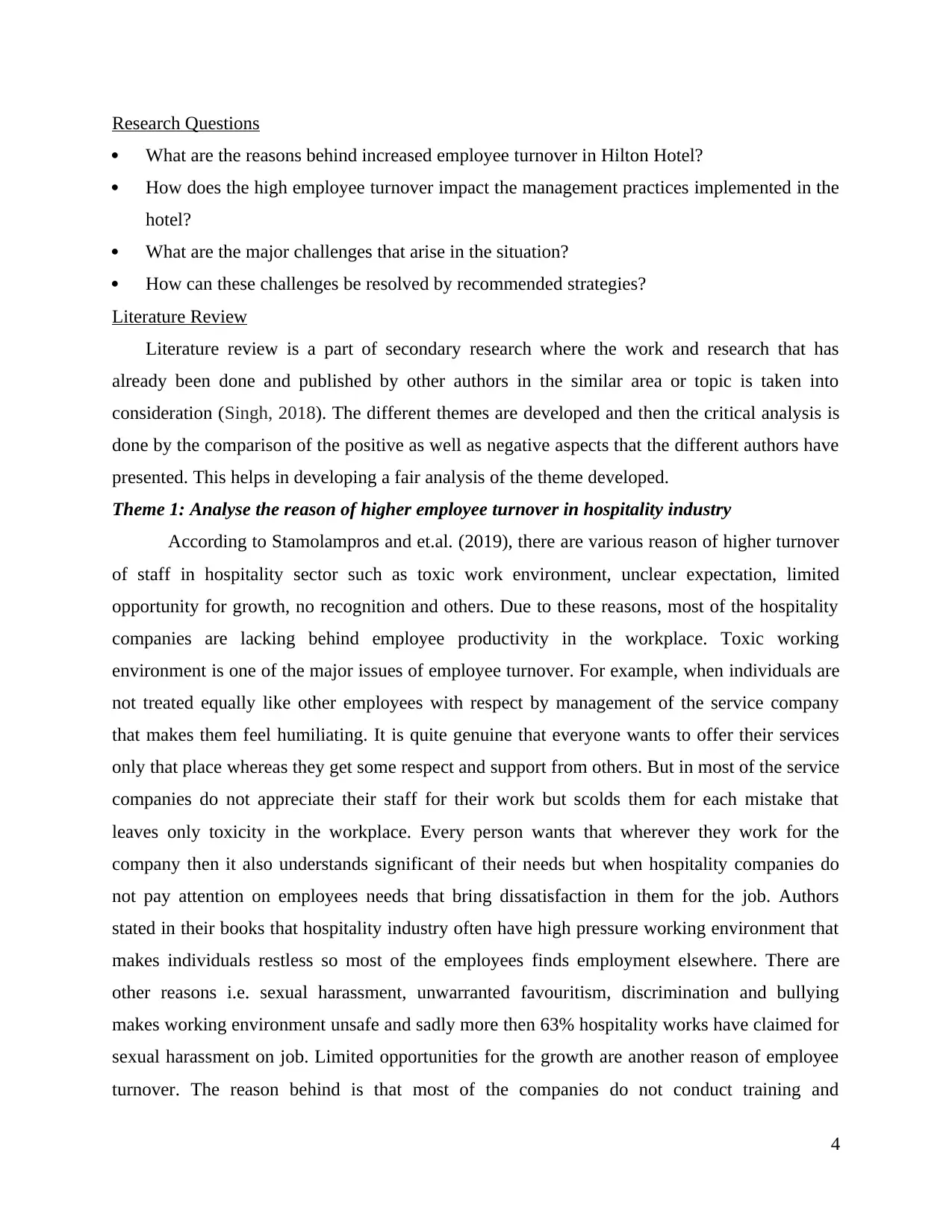
Research Questions
What are the reasons behind increased employee turnover in Hilton Hotel?
How does the high employee turnover impact the management practices implemented in the
hotel?
What are the major challenges that arise in the situation?
How can these challenges be resolved by recommended strategies?
Literature Review
Literature review is a part of secondary research where the work and research that has
already been done and published by other authors in the similar area or topic is taken into
consideration (Singh, 2018). The different themes are developed and then the critical analysis is
done by the comparison of the positive as well as negative aspects that the different authors have
presented. This helps in developing a fair analysis of the theme developed.
Theme 1: Analyse the reason of higher employee turnover in hospitality industry
According to Stamolampros and et.al. (2019), there are various reason of higher turnover
of staff in hospitality sector such as toxic work environment, unclear expectation, limited
opportunity for growth, no recognition and others. Due to these reasons, most of the hospitality
companies are lacking behind employee productivity in the workplace. Toxic working
environment is one of the major issues of employee turnover. For example, when individuals are
not treated equally like other employees with respect by management of the service company
that makes them feel humiliating. It is quite genuine that everyone wants to offer their services
only that place whereas they get some respect and support from others. But in most of the service
companies do not appreciate their staff for their work but scolds them for each mistake that
leaves only toxicity in the workplace. Every person wants that wherever they work for the
company then it also understands significant of their needs but when hospitality companies do
not pay attention on employees needs that bring dissatisfaction in them for the job. Authors
stated in their books that hospitality industry often have high pressure working environment that
makes individuals restless so most of the employees finds employment elsewhere. There are
other reasons i.e. sexual harassment, unwarranted favouritism, discrimination and bullying
makes working environment unsafe and sadly more then 63% hospitality works have claimed for
sexual harassment on job. Limited opportunities for the growth are another reason of employee
turnover. The reason behind is that most of the companies do not conduct training and
4
What are the reasons behind increased employee turnover in Hilton Hotel?
How does the high employee turnover impact the management practices implemented in the
hotel?
What are the major challenges that arise in the situation?
How can these challenges be resolved by recommended strategies?
Literature Review
Literature review is a part of secondary research where the work and research that has
already been done and published by other authors in the similar area or topic is taken into
consideration (Singh, 2018). The different themes are developed and then the critical analysis is
done by the comparison of the positive as well as negative aspects that the different authors have
presented. This helps in developing a fair analysis of the theme developed.
Theme 1: Analyse the reason of higher employee turnover in hospitality industry
According to Stamolampros and et.al. (2019), there are various reason of higher turnover
of staff in hospitality sector such as toxic work environment, unclear expectation, limited
opportunity for growth, no recognition and others. Due to these reasons, most of the hospitality
companies are lacking behind employee productivity in the workplace. Toxic working
environment is one of the major issues of employee turnover. For example, when individuals are
not treated equally like other employees with respect by management of the service company
that makes them feel humiliating. It is quite genuine that everyone wants to offer their services
only that place whereas they get some respect and support from others. But in most of the service
companies do not appreciate their staff for their work but scolds them for each mistake that
leaves only toxicity in the workplace. Every person wants that wherever they work for the
company then it also understands significant of their needs but when hospitality companies do
not pay attention on employees needs that bring dissatisfaction in them for the job. Authors
stated in their books that hospitality industry often have high pressure working environment that
makes individuals restless so most of the employees finds employment elsewhere. There are
other reasons i.e. sexual harassment, unwarranted favouritism, discrimination and bullying
makes working environment unsafe and sadly more then 63% hospitality works have claimed for
sexual harassment on job. Limited opportunities for the growth are another reason of employee
turnover. The reason behind is that most of the companies do not conduct training and
4
Paraphrase This Document
Need a fresh take? Get an instant paraphrase of this document with our AI Paraphraser
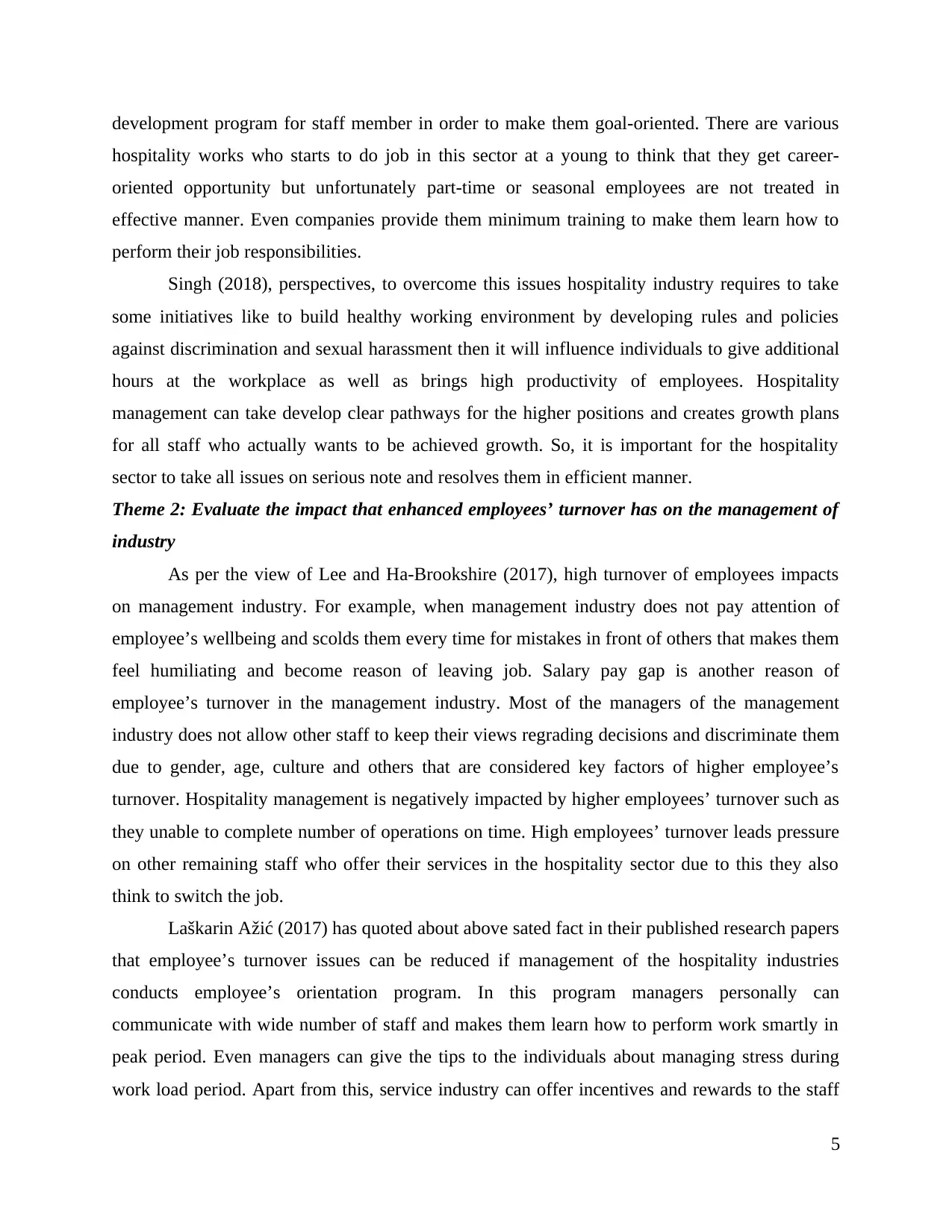
development program for staff member in order to make them goal-oriented. There are various
hospitality works who starts to do job in this sector at a young to think that they get career-
oriented opportunity but unfortunately part-time or seasonal employees are not treated in
effective manner. Even companies provide them minimum training to make them learn how to
perform their job responsibilities.
Singh (2018), perspectives, to overcome this issues hospitality industry requires to take
some initiatives like to build healthy working environment by developing rules and policies
against discrimination and sexual harassment then it will influence individuals to give additional
hours at the workplace as well as brings high productivity of employees. Hospitality
management can take develop clear pathways for the higher positions and creates growth plans
for all staff who actually wants to be achieved growth. So, it is important for the hospitality
sector to take all issues on serious note and resolves them in efficient manner.
Theme 2: Evaluate the impact that enhanced employees’ turnover has on the management of
industry
As per the view of Lee and Ha-Brookshire (2017), high turnover of employees impacts
on management industry. For example, when management industry does not pay attention of
employee’s wellbeing and scolds them every time for mistakes in front of others that makes them
feel humiliating and become reason of leaving job. Salary pay gap is another reason of
employee’s turnover in the management industry. Most of the managers of the management
industry does not allow other staff to keep their views regrading decisions and discriminate them
due to gender, age, culture and others that are considered key factors of higher employee’s
turnover. Hospitality management is negatively impacted by higher employees’ turnover such as
they unable to complete number of operations on time. High employees’ turnover leads pressure
on other remaining staff who offer their services in the hospitality sector due to this they also
think to switch the job.
Laškarin Ažić (2017) has quoted about above sated fact in their published research papers
that employee’s turnover issues can be reduced if management of the hospitality industries
conducts employee’s orientation program. In this program managers personally can
communicate with wide number of staff and makes them learn how to perform work smartly in
peak period. Even managers can give the tips to the individuals about managing stress during
work load period. Apart from this, service industry can offer incentives and rewards to the staff
5
hospitality works who starts to do job in this sector at a young to think that they get career-
oriented opportunity but unfortunately part-time or seasonal employees are not treated in
effective manner. Even companies provide them minimum training to make them learn how to
perform their job responsibilities.
Singh (2018), perspectives, to overcome this issues hospitality industry requires to take
some initiatives like to build healthy working environment by developing rules and policies
against discrimination and sexual harassment then it will influence individuals to give additional
hours at the workplace as well as brings high productivity of employees. Hospitality
management can take develop clear pathways for the higher positions and creates growth plans
for all staff who actually wants to be achieved growth. So, it is important for the hospitality
sector to take all issues on serious note and resolves them in efficient manner.
Theme 2: Evaluate the impact that enhanced employees’ turnover has on the management of
industry
As per the view of Lee and Ha-Brookshire (2017), high turnover of employees impacts
on management industry. For example, when management industry does not pay attention of
employee’s wellbeing and scolds them every time for mistakes in front of others that makes them
feel humiliating and become reason of leaving job. Salary pay gap is another reason of
employee’s turnover in the management industry. Most of the managers of the management
industry does not allow other staff to keep their views regrading decisions and discriminate them
due to gender, age, culture and others that are considered key factors of higher employee’s
turnover. Hospitality management is negatively impacted by higher employees’ turnover such as
they unable to complete number of operations on time. High employees’ turnover leads pressure
on other remaining staff who offer their services in the hospitality sector due to this they also
think to switch the job.
Laškarin Ažić (2017) has quoted about above sated fact in their published research papers
that employee’s turnover issues can be reduced if management of the hospitality industries
conducts employee’s orientation program. In this program managers personally can
communicate with wide number of staff and makes them learn how to perform work smartly in
peak period. Even managers can give the tips to the individuals about managing stress during
work load period. Apart from this, service industry can offer incentives and rewards to the staff
5
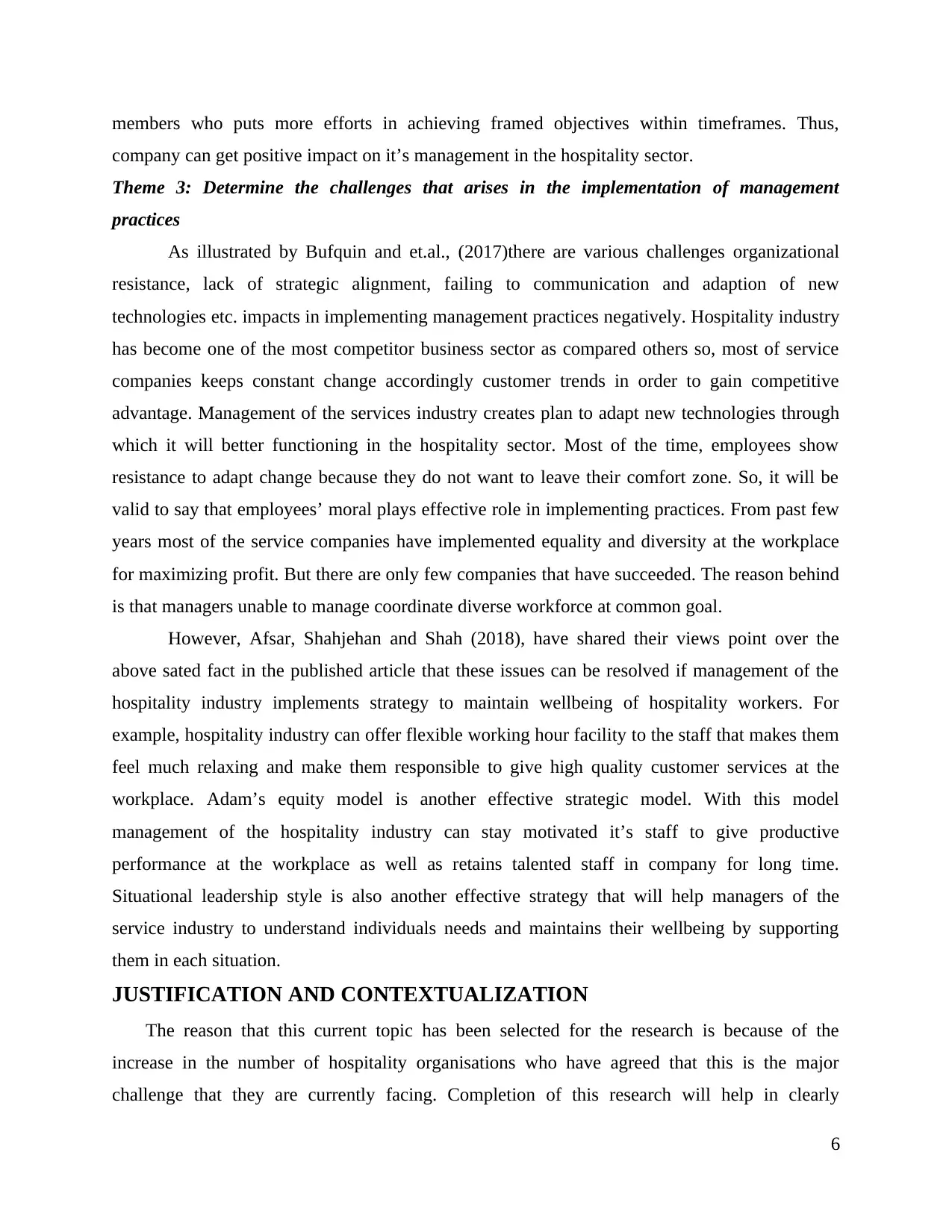
members who puts more efforts in achieving framed objectives within timeframes. Thus,
company can get positive impact on it’s management in the hospitality sector.
Theme 3: Determine the challenges that arises in the implementation of management
practices
As illustrated by Bufquin and et.al., (2017)there are various challenges organizational
resistance, lack of strategic alignment, failing to communication and adaption of new
technologies etc. impacts in implementing management practices negatively. Hospitality industry
has become one of the most competitor business sector as compared others so, most of service
companies keeps constant change accordingly customer trends in order to gain competitive
advantage. Management of the services industry creates plan to adapt new technologies through
which it will better functioning in the hospitality sector. Most of the time, employees show
resistance to adapt change because they do not want to leave their comfort zone. So, it will be
valid to say that employees’ moral plays effective role in implementing practices. From past few
years most of the service companies have implemented equality and diversity at the workplace
for maximizing profit. But there are only few companies that have succeeded. The reason behind
is that managers unable to manage coordinate diverse workforce at common goal.
However, Afsar, Shahjehan and Shah (2018), have shared their views point over the
above sated fact in the published article that these issues can be resolved if management of the
hospitality industry implements strategy to maintain wellbeing of hospitality workers. For
example, hospitality industry can offer flexible working hour facility to the staff that makes them
feel much relaxing and make them responsible to give high quality customer services at the
workplace. Adam’s equity model is another effective strategic model. With this model
management of the hospitality industry can stay motivated it’s staff to give productive
performance at the workplace as well as retains talented staff in company for long time.
Situational leadership style is also another effective strategy that will help managers of the
service industry to understand individuals needs and maintains their wellbeing by supporting
them in each situation.
JUSTIFICATION AND CONTEXTUALIZATION
The reason that this current topic has been selected for the research is because of the
increase in the number of hospitality organisations who have agreed that this is the major
challenge that they are currently facing. Completion of this research will help in clearly
6
company can get positive impact on it’s management in the hospitality sector.
Theme 3: Determine the challenges that arises in the implementation of management
practices
As illustrated by Bufquin and et.al., (2017)there are various challenges organizational
resistance, lack of strategic alignment, failing to communication and adaption of new
technologies etc. impacts in implementing management practices negatively. Hospitality industry
has become one of the most competitor business sector as compared others so, most of service
companies keeps constant change accordingly customer trends in order to gain competitive
advantage. Management of the services industry creates plan to adapt new technologies through
which it will better functioning in the hospitality sector. Most of the time, employees show
resistance to adapt change because they do not want to leave their comfort zone. So, it will be
valid to say that employees’ moral plays effective role in implementing practices. From past few
years most of the service companies have implemented equality and diversity at the workplace
for maximizing profit. But there are only few companies that have succeeded. The reason behind
is that managers unable to manage coordinate diverse workforce at common goal.
However, Afsar, Shahjehan and Shah (2018), have shared their views point over the
above sated fact in the published article that these issues can be resolved if management of the
hospitality industry implements strategy to maintain wellbeing of hospitality workers. For
example, hospitality industry can offer flexible working hour facility to the staff that makes them
feel much relaxing and make them responsible to give high quality customer services at the
workplace. Adam’s equity model is another effective strategic model. With this model
management of the hospitality industry can stay motivated it’s staff to give productive
performance at the workplace as well as retains talented staff in company for long time.
Situational leadership style is also another effective strategy that will help managers of the
service industry to understand individuals needs and maintains their wellbeing by supporting
them in each situation.
JUSTIFICATION AND CONTEXTUALIZATION
The reason that this current topic has been selected for the research is because of the
increase in the number of hospitality organisations who have agreed that this is the major
challenge that they are currently facing. Completion of this research will help in clearly
6
⊘ This is a preview!⊘
Do you want full access?
Subscribe today to unlock all pages.

Trusted by 1+ million students worldwide
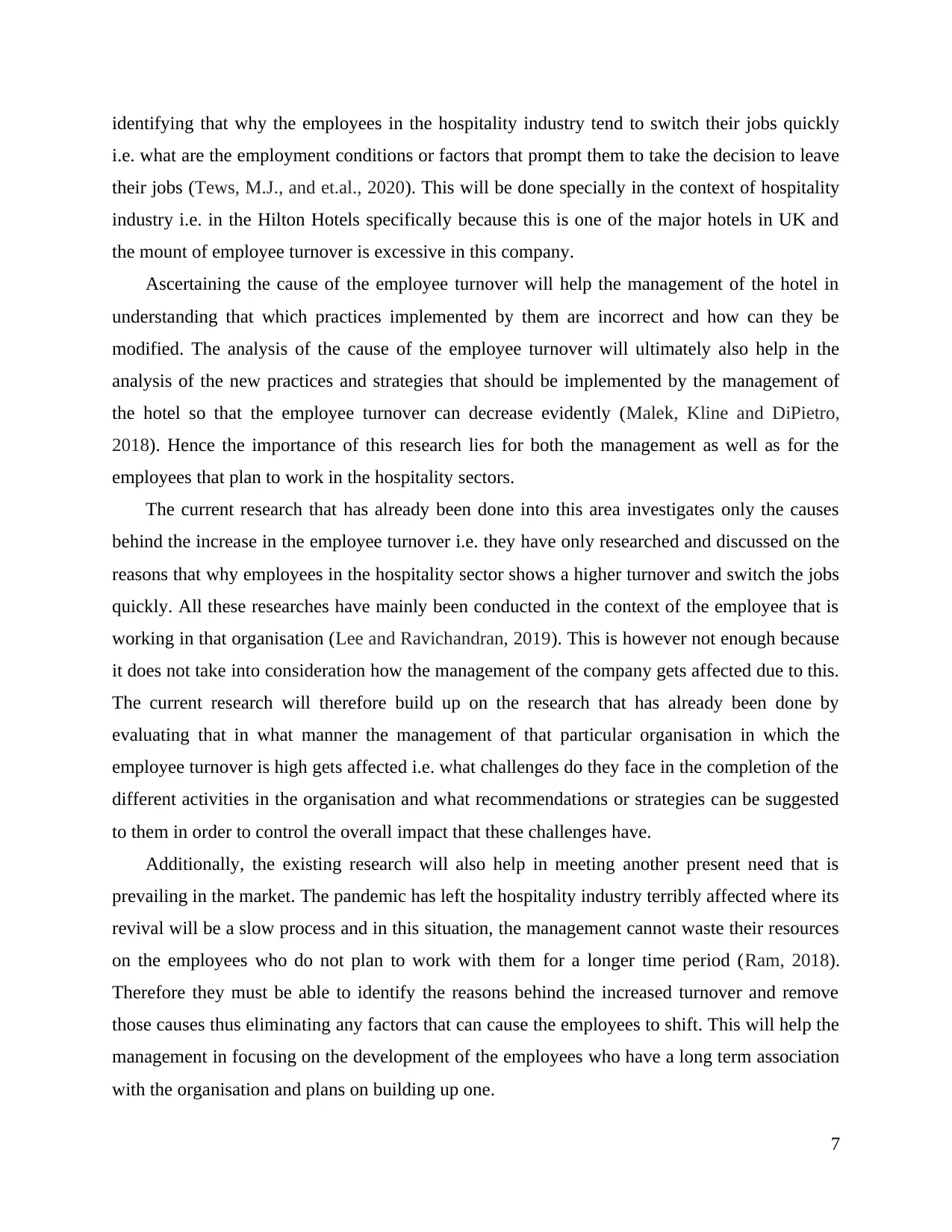
identifying that why the employees in the hospitality industry tend to switch their jobs quickly
i.e. what are the employment conditions or factors that prompt them to take the decision to leave
their jobs (Tews, M.J., and et.al., 2020). This will be done specially in the context of hospitality
industry i.e. in the Hilton Hotels specifically because this is one of the major hotels in UK and
the mount of employee turnover is excessive in this company.
Ascertaining the cause of the employee turnover will help the management of the hotel in
understanding that which practices implemented by them are incorrect and how can they be
modified. The analysis of the cause of the employee turnover will ultimately also help in the
analysis of the new practices and strategies that should be implemented by the management of
the hotel so that the employee turnover can decrease evidently (Malek, Kline and DiPietro,
2018). Hence the importance of this research lies for both the management as well as for the
employees that plan to work in the hospitality sectors.
The current research that has already been done into this area investigates only the causes
behind the increase in the employee turnover i.e. they have only researched and discussed on the
reasons that why employees in the hospitality sector shows a higher turnover and switch the jobs
quickly. All these researches have mainly been conducted in the context of the employee that is
working in that organisation (Lee and Ravichandran, 2019). This is however not enough because
it does not take into consideration how the management of the company gets affected due to this.
The current research will therefore build up on the research that has already been done by
evaluating that in what manner the management of that particular organisation in which the
employee turnover is high gets affected i.e. what challenges do they face in the completion of the
different activities in the organisation and what recommendations or strategies can be suggested
to them in order to control the overall impact that these challenges have.
Additionally, the existing research will also help in meeting another present need that is
prevailing in the market. The pandemic has left the hospitality industry terribly affected where its
revival will be a slow process and in this situation, the management cannot waste their resources
on the employees who do not plan to work with them for a longer time period (Ram, 2018).
Therefore they must be able to identify the reasons behind the increased turnover and remove
those causes thus eliminating any factors that can cause the employees to shift. This will help the
management in focusing on the development of the employees who have a long term association
with the organisation and plans on building up one.
7
i.e. what are the employment conditions or factors that prompt them to take the decision to leave
their jobs (Tews, M.J., and et.al., 2020). This will be done specially in the context of hospitality
industry i.e. in the Hilton Hotels specifically because this is one of the major hotels in UK and
the mount of employee turnover is excessive in this company.
Ascertaining the cause of the employee turnover will help the management of the hotel in
understanding that which practices implemented by them are incorrect and how can they be
modified. The analysis of the cause of the employee turnover will ultimately also help in the
analysis of the new practices and strategies that should be implemented by the management of
the hotel so that the employee turnover can decrease evidently (Malek, Kline and DiPietro,
2018). Hence the importance of this research lies for both the management as well as for the
employees that plan to work in the hospitality sectors.
The current research that has already been done into this area investigates only the causes
behind the increase in the employee turnover i.e. they have only researched and discussed on the
reasons that why employees in the hospitality sector shows a higher turnover and switch the jobs
quickly. All these researches have mainly been conducted in the context of the employee that is
working in that organisation (Lee and Ravichandran, 2019). This is however not enough because
it does not take into consideration how the management of the company gets affected due to this.
The current research will therefore build up on the research that has already been done by
evaluating that in what manner the management of that particular organisation in which the
employee turnover is high gets affected i.e. what challenges do they face in the completion of the
different activities in the organisation and what recommendations or strategies can be suggested
to them in order to control the overall impact that these challenges have.
Additionally, the existing research will also help in meeting another present need that is
prevailing in the market. The pandemic has left the hospitality industry terribly affected where its
revival will be a slow process and in this situation, the management cannot waste their resources
on the employees who do not plan to work with them for a longer time period (Ram, 2018).
Therefore they must be able to identify the reasons behind the increased turnover and remove
those causes thus eliminating any factors that can cause the employees to shift. This will help the
management in focusing on the development of the employees who have a long term association
with the organisation and plans on building up one.
7
Paraphrase This Document
Need a fresh take? Get an instant paraphrase of this document with our AI Paraphraser
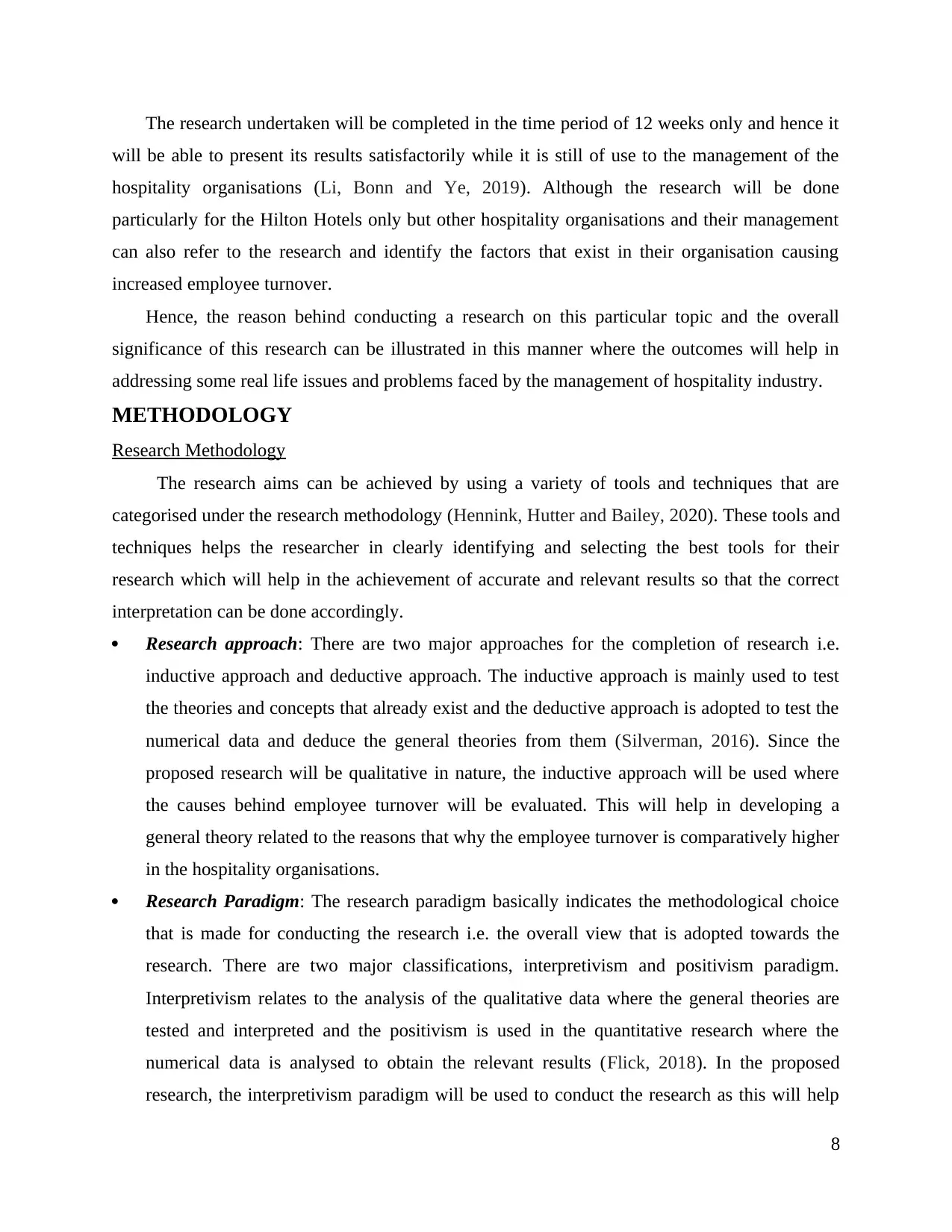
The research undertaken will be completed in the time period of 12 weeks only and hence it
will be able to present its results satisfactorily while it is still of use to the management of the
hospitality organisations (Li, Bonn and Ye, 2019). Although the research will be done
particularly for the Hilton Hotels only but other hospitality organisations and their management
can also refer to the research and identify the factors that exist in their organisation causing
increased employee turnover.
Hence, the reason behind conducting a research on this particular topic and the overall
significance of this research can be illustrated in this manner where the outcomes will help in
addressing some real life issues and problems faced by the management of hospitality industry.
METHODOLOGY
Research Methodology
The research aims can be achieved by using a variety of tools and techniques that are
categorised under the research methodology (Hennink, Hutter and Bailey, 2020). These tools and
techniques helps the researcher in clearly identifying and selecting the best tools for their
research which will help in the achievement of accurate and relevant results so that the correct
interpretation can be done accordingly.
Research approach: There are two major approaches for the completion of research i.e.
inductive approach and deductive approach. The inductive approach is mainly used to test
the theories and concepts that already exist and the deductive approach is adopted to test the
numerical data and deduce the general theories from them (Silverman, 2016). Since the
proposed research will be qualitative in nature, the inductive approach will be used where
the causes behind employee turnover will be evaluated. This will help in developing a
general theory related to the reasons that why the employee turnover is comparatively higher
in the hospitality organisations.
Research Paradigm: The research paradigm basically indicates the methodological choice
that is made for conducting the research i.e. the overall view that is adopted towards the
research. There are two major classifications, interpretivism and positivism paradigm.
Interpretivism relates to the analysis of the qualitative data where the general theories are
tested and interpreted and the positivism is used in the quantitative research where the
numerical data is analysed to obtain the relevant results (Flick, 2018). In the proposed
research, the interpretivism paradigm will be used to conduct the research as this will help
8
will be able to present its results satisfactorily while it is still of use to the management of the
hospitality organisations (Li, Bonn and Ye, 2019). Although the research will be done
particularly for the Hilton Hotels only but other hospitality organisations and their management
can also refer to the research and identify the factors that exist in their organisation causing
increased employee turnover.
Hence, the reason behind conducting a research on this particular topic and the overall
significance of this research can be illustrated in this manner where the outcomes will help in
addressing some real life issues and problems faced by the management of hospitality industry.
METHODOLOGY
Research Methodology
The research aims can be achieved by using a variety of tools and techniques that are
categorised under the research methodology (Hennink, Hutter and Bailey, 2020). These tools and
techniques helps the researcher in clearly identifying and selecting the best tools for their
research which will help in the achievement of accurate and relevant results so that the correct
interpretation can be done accordingly.
Research approach: There are two major approaches for the completion of research i.e.
inductive approach and deductive approach. The inductive approach is mainly used to test
the theories and concepts that already exist and the deductive approach is adopted to test the
numerical data and deduce the general theories from them (Silverman, 2016). Since the
proposed research will be qualitative in nature, the inductive approach will be used where
the causes behind employee turnover will be evaluated. This will help in developing a
general theory related to the reasons that why the employee turnover is comparatively higher
in the hospitality organisations.
Research Paradigm: The research paradigm basically indicates the methodological choice
that is made for conducting the research i.e. the overall view that is adopted towards the
research. There are two major classifications, interpretivism and positivism paradigm.
Interpretivism relates to the analysis of the qualitative data where the general theories are
tested and interpreted and the positivism is used in the quantitative research where the
numerical data is analysed to obtain the relevant results (Flick, 2018). In the proposed
research, the interpretivism paradigm will be used to conduct the research as this will help
8

the research in integrating all the qualitative aspects associated with the research on impact
that increased employee turnover has on the overall management practices in Hilton Hotel.
Data Collection: Data collection can be done through primary and secondary data. Primary
data is the original data that can be collected using different techniques like surveys,
questionnaires, observation method, case study etc. and secondary research is done in the
form if literatures review where the already published data is analysed and interpreted. In the
proposed research, both primary and secondary data collection tools will be used i.e.
questionnaire method will be used to collect and interpret relevant data and the secondary
research will be used to analyse the research that has already been conducted (Merriam and
Grenier, 2019). The primary data through questionnaire will be collected through online
mediums only i.e. no physical contacts will be made unless absolutely necessary and the
different tools such as telephonic communication, video conferencing, emails etc. will be
used to collect all primary data. This will help in obtaining comprehensive and justified
results for the research.
Sampling: Sampling can be done using the probability and non- probability sampling
method and in the proposed research, purposive non- probability sampling will be used by
the researcher. Here the respondents will be selected randomly out of the universe that
comprises of some selected individuals only (Myers, 2019). In the current research 30
respondents will be selected randomly out of all the management staff working in the Hilton
Hotel. They will help in analysing the impact that the higher turnover amongst the
employees has on their working and management efficiency. This will collectively help in
the comprehensive accumulation of the primary data relevantly.
Data analysis: The data analysis can be done differently for the qualitative or quantitative
research. For qualitative research thematic analysis technique is used where the different
themes based on the objectives are developed and the various, graphs, bars, charts etc. are
used to interpret and present the data accordingly (Tracy, 2019). In the quantitative analysis,
software like SPSS, MS- Excel etc. is used to analyse the data accordingly. For the proposed
qualitative research, thematic analysis technique will be used to analyse the data that has
been collected relevantly and draw results accordingly.
The use of these selected tools will help in the completion of the research in the most
effective way where the desired objectives of the research can be achieved comprehensively.
9
that increased employee turnover has on the overall management practices in Hilton Hotel.
Data Collection: Data collection can be done through primary and secondary data. Primary
data is the original data that can be collected using different techniques like surveys,
questionnaires, observation method, case study etc. and secondary research is done in the
form if literatures review where the already published data is analysed and interpreted. In the
proposed research, both primary and secondary data collection tools will be used i.e.
questionnaire method will be used to collect and interpret relevant data and the secondary
research will be used to analyse the research that has already been conducted (Merriam and
Grenier, 2019). The primary data through questionnaire will be collected through online
mediums only i.e. no physical contacts will be made unless absolutely necessary and the
different tools such as telephonic communication, video conferencing, emails etc. will be
used to collect all primary data. This will help in obtaining comprehensive and justified
results for the research.
Sampling: Sampling can be done using the probability and non- probability sampling
method and in the proposed research, purposive non- probability sampling will be used by
the researcher. Here the respondents will be selected randomly out of the universe that
comprises of some selected individuals only (Myers, 2019). In the current research 30
respondents will be selected randomly out of all the management staff working in the Hilton
Hotel. They will help in analysing the impact that the higher turnover amongst the
employees has on their working and management efficiency. This will collectively help in
the comprehensive accumulation of the primary data relevantly.
Data analysis: The data analysis can be done differently for the qualitative or quantitative
research. For qualitative research thematic analysis technique is used where the different
themes based on the objectives are developed and the various, graphs, bars, charts etc. are
used to interpret and present the data accordingly (Tracy, 2019). In the quantitative analysis,
software like SPSS, MS- Excel etc. is used to analyse the data accordingly. For the proposed
qualitative research, thematic analysis technique will be used to analyse the data that has
been collected relevantly and draw results accordingly.
The use of these selected tools will help in the completion of the research in the most
effective way where the desired objectives of the research can be achieved comprehensively.
9
⊘ This is a preview!⊘
Do you want full access?
Subscribe today to unlock all pages.

Trusted by 1+ million students worldwide
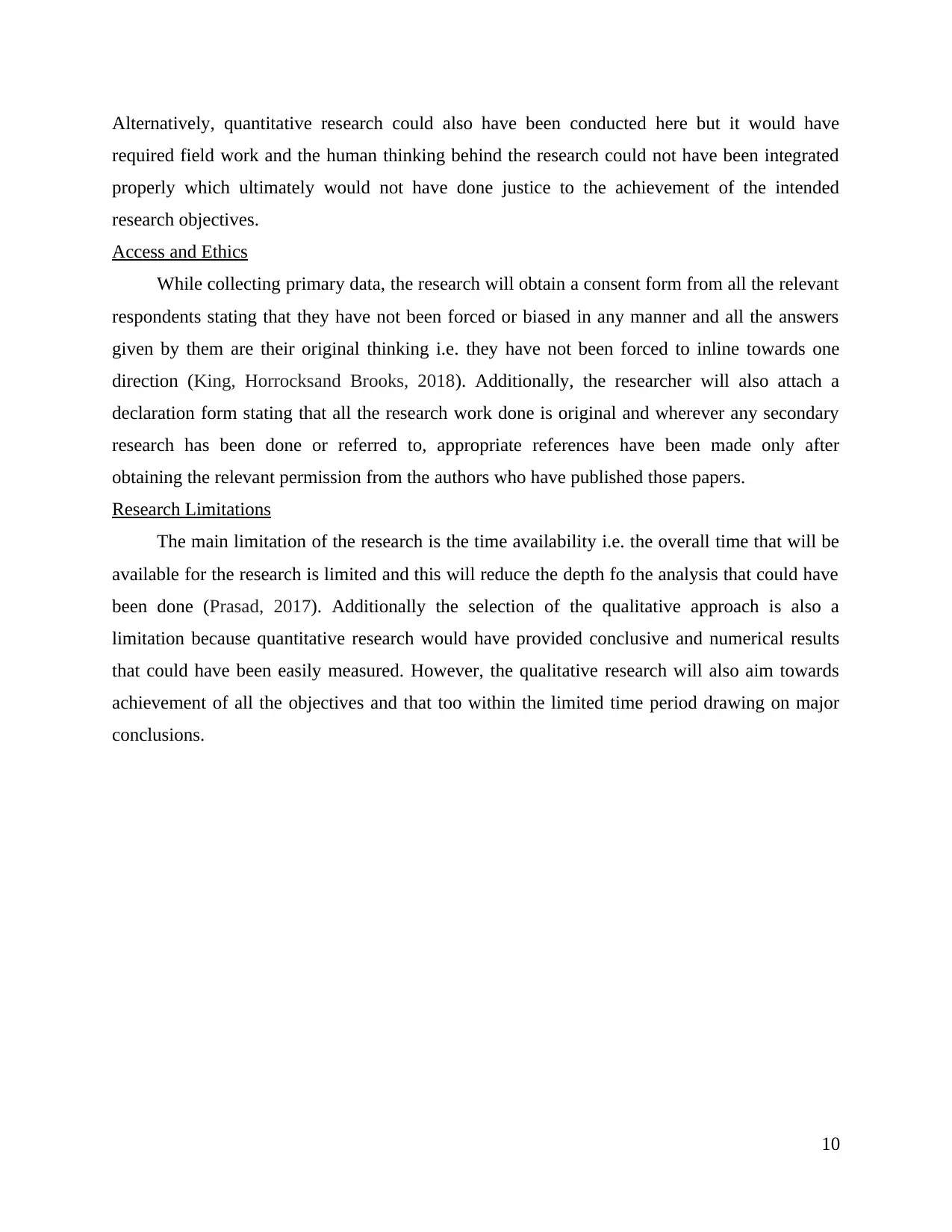
Alternatively, quantitative research could also have been conducted here but it would have
required field work and the human thinking behind the research could not have been integrated
properly which ultimately would not have done justice to the achievement of the intended
research objectives.
Access and Ethics
While collecting primary data, the research will obtain a consent form from all the relevant
respondents stating that they have not been forced or biased in any manner and all the answers
given by them are their original thinking i.e. they have not been forced to inline towards one
direction (King, Horrocksand Brooks, 2018). Additionally, the researcher will also attach a
declaration form stating that all the research work done is original and wherever any secondary
research has been done or referred to, appropriate references have been made only after
obtaining the relevant permission from the authors who have published those papers.
Research Limitations
The main limitation of the research is the time availability i.e. the overall time that will be
available for the research is limited and this will reduce the depth fo the analysis that could have
been done (Prasad, 2017). Additionally the selection of the qualitative approach is also a
limitation because quantitative research would have provided conclusive and numerical results
that could have been easily measured. However, the qualitative research will also aim towards
achievement of all the objectives and that too within the limited time period drawing on major
conclusions.
10
required field work and the human thinking behind the research could not have been integrated
properly which ultimately would not have done justice to the achievement of the intended
research objectives.
Access and Ethics
While collecting primary data, the research will obtain a consent form from all the relevant
respondents stating that they have not been forced or biased in any manner and all the answers
given by them are their original thinking i.e. they have not been forced to inline towards one
direction (King, Horrocksand Brooks, 2018). Additionally, the researcher will also attach a
declaration form stating that all the research work done is original and wherever any secondary
research has been done or referred to, appropriate references have been made only after
obtaining the relevant permission from the authors who have published those papers.
Research Limitations
The main limitation of the research is the time availability i.e. the overall time that will be
available for the research is limited and this will reduce the depth fo the analysis that could have
been done (Prasad, 2017). Additionally the selection of the qualitative approach is also a
limitation because quantitative research would have provided conclusive and numerical results
that could have been easily measured. However, the qualitative research will also aim towards
achievement of all the objectives and that too within the limited time period drawing on major
conclusions.
10
Paraphrase This Document
Need a fresh take? Get an instant paraphrase of this document with our AI Paraphraser
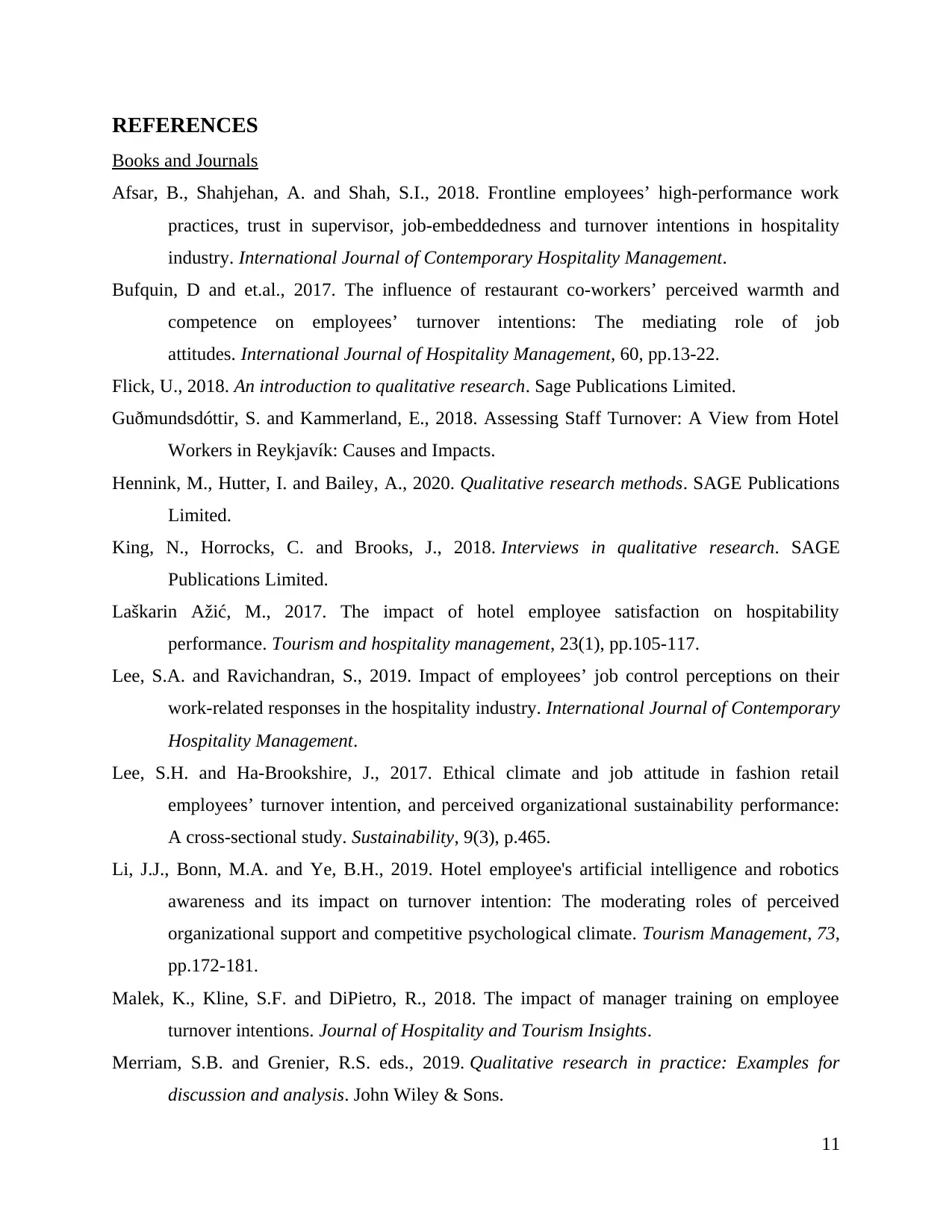
REFERENCES
Books and Journals
Afsar, B., Shahjehan, A. and Shah, S.I., 2018. Frontline employees’ high-performance work
practices, trust in supervisor, job-embeddedness and turnover intentions in hospitality
industry. International Journal of Contemporary Hospitality Management.
Bufquin, D and et.al., 2017. The influence of restaurant co-workers’ perceived warmth and
competence on employees’ turnover intentions: The mediating role of job
attitudes. International Journal of Hospitality Management, 60, pp.13-22.
Flick, U., 2018. An introduction to qualitative research. Sage Publications Limited.
Guðmundsdóttir, S. and Kammerland, E., 2018. Assessing Staff Turnover: A View from Hotel
Workers in Reykjavík: Causes and Impacts.
Hennink, M., Hutter, I. and Bailey, A., 2020. Qualitative research methods. SAGE Publications
Limited.
King, N., Horrocks, C. and Brooks, J., 2018. Interviews in qualitative research. SAGE
Publications Limited.
Laškarin Ažić, M., 2017. The impact of hotel employee satisfaction on hospitability
performance. Tourism and hospitality management, 23(1), pp.105-117.
Lee, S.A. and Ravichandran, S., 2019. Impact of employees’ job control perceptions on their
work-related responses in the hospitality industry. International Journal of Contemporary
Hospitality Management.
Lee, S.H. and Ha-Brookshire, J., 2017. Ethical climate and job attitude in fashion retail
employees’ turnover intention, and perceived organizational sustainability performance:
A cross-sectional study. Sustainability, 9(3), p.465.
Li, J.J., Bonn, M.A. and Ye, B.H., 2019. Hotel employee's artificial intelligence and robotics
awareness and its impact on turnover intention: The moderating roles of perceived
organizational support and competitive psychological climate. Tourism Management, 73,
pp.172-181.
Malek, K., Kline, S.F. and DiPietro, R., 2018. The impact of manager training on employee
turnover intentions. Journal of Hospitality and Tourism Insights.
Merriam, S.B. and Grenier, R.S. eds., 2019. Qualitative research in practice: Examples for
discussion and analysis. John Wiley & Sons.
11
Books and Journals
Afsar, B., Shahjehan, A. and Shah, S.I., 2018. Frontline employees’ high-performance work
practices, trust in supervisor, job-embeddedness and turnover intentions in hospitality
industry. International Journal of Contemporary Hospitality Management.
Bufquin, D and et.al., 2017. The influence of restaurant co-workers’ perceived warmth and
competence on employees’ turnover intentions: The mediating role of job
attitudes. International Journal of Hospitality Management, 60, pp.13-22.
Flick, U., 2018. An introduction to qualitative research. Sage Publications Limited.
Guðmundsdóttir, S. and Kammerland, E., 2018. Assessing Staff Turnover: A View from Hotel
Workers in Reykjavík: Causes and Impacts.
Hennink, M., Hutter, I. and Bailey, A., 2020. Qualitative research methods. SAGE Publications
Limited.
King, N., Horrocks, C. and Brooks, J., 2018. Interviews in qualitative research. SAGE
Publications Limited.
Laškarin Ažić, M., 2017. The impact of hotel employee satisfaction on hospitability
performance. Tourism and hospitality management, 23(1), pp.105-117.
Lee, S.A. and Ravichandran, S., 2019. Impact of employees’ job control perceptions on their
work-related responses in the hospitality industry. International Journal of Contemporary
Hospitality Management.
Lee, S.H. and Ha-Brookshire, J., 2017. Ethical climate and job attitude in fashion retail
employees’ turnover intention, and perceived organizational sustainability performance:
A cross-sectional study. Sustainability, 9(3), p.465.
Li, J.J., Bonn, M.A. and Ye, B.H., 2019. Hotel employee's artificial intelligence and robotics
awareness and its impact on turnover intention: The moderating roles of perceived
organizational support and competitive psychological climate. Tourism Management, 73,
pp.172-181.
Malek, K., Kline, S.F. and DiPietro, R., 2018. The impact of manager training on employee
turnover intentions. Journal of Hospitality and Tourism Insights.
Merriam, S.B. and Grenier, R.S. eds., 2019. Qualitative research in practice: Examples for
discussion and analysis. John Wiley & Sons.
11
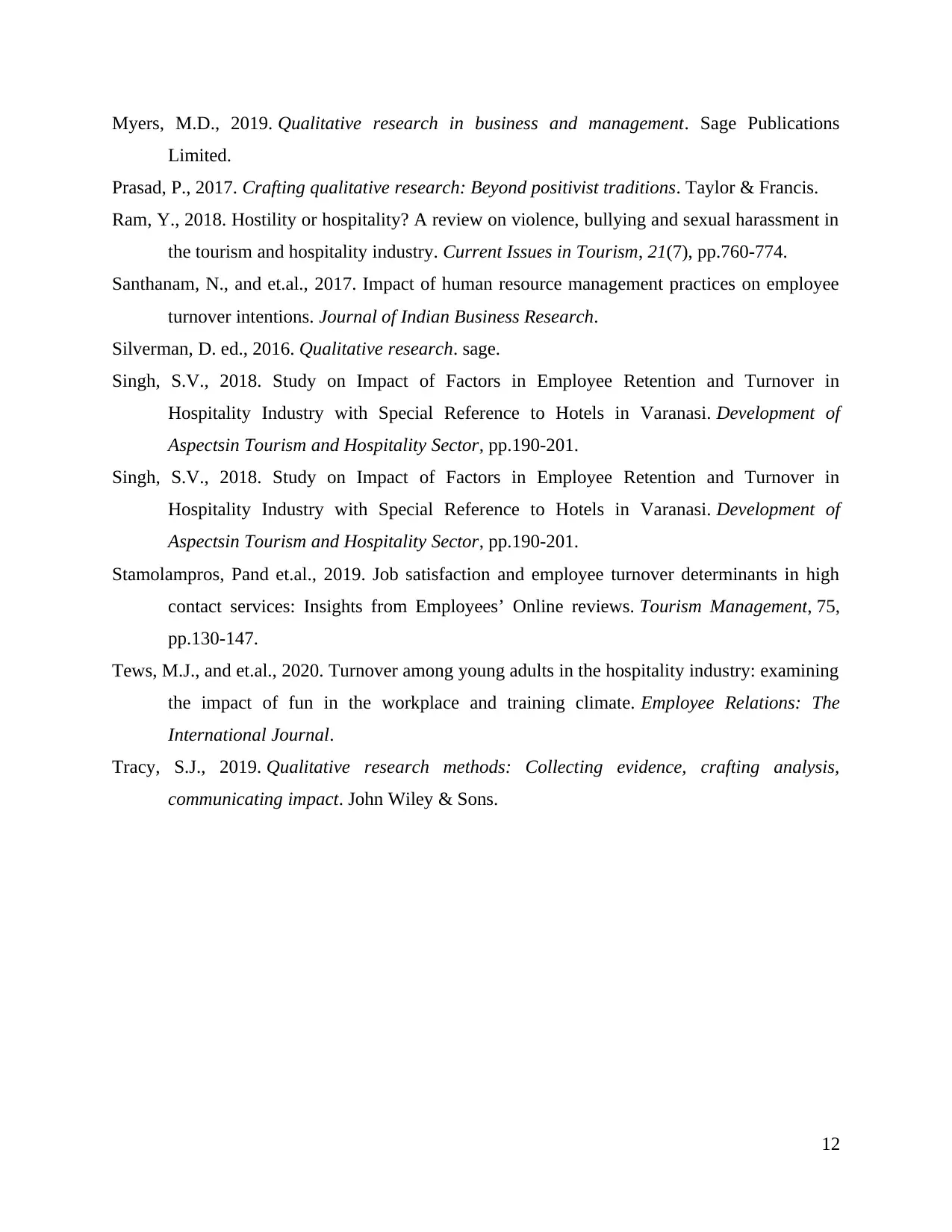
Myers, M.D., 2019. Qualitative research in business and management. Sage Publications
Limited.
Prasad, P., 2017. Crafting qualitative research: Beyond positivist traditions. Taylor & Francis.
Ram, Y., 2018. Hostility or hospitality? A review on violence, bullying and sexual harassment in
the tourism and hospitality industry. Current Issues in Tourism, 21(7), pp.760-774.
Santhanam, N., and et.al., 2017. Impact of human resource management practices on employee
turnover intentions. Journal of Indian Business Research.
Silverman, D. ed., 2016. Qualitative research. sage.
Singh, S.V., 2018. Study on Impact of Factors in Employee Retention and Turnover in
Hospitality Industry with Special Reference to Hotels in Varanasi. Development of
Aspectsin Tourism and Hospitality Sector, pp.190-201.
Singh, S.V., 2018. Study on Impact of Factors in Employee Retention and Turnover in
Hospitality Industry with Special Reference to Hotels in Varanasi. Development of
Aspectsin Tourism and Hospitality Sector, pp.190-201.
Stamolampros, Pand et.al., 2019. Job satisfaction and employee turnover determinants in high
contact services: Insights from Employees’ Online reviews. Tourism Management, 75,
pp.130-147.
Tews, M.J., and et.al., 2020. Turnover among young adults in the hospitality industry: examining
the impact of fun in the workplace and training climate. Employee Relations: The
International Journal.
Tracy, S.J., 2019. Qualitative research methods: Collecting evidence, crafting analysis,
communicating impact. John Wiley & Sons.
12
Limited.
Prasad, P., 2017. Crafting qualitative research: Beyond positivist traditions. Taylor & Francis.
Ram, Y., 2018. Hostility or hospitality? A review on violence, bullying and sexual harassment in
the tourism and hospitality industry. Current Issues in Tourism, 21(7), pp.760-774.
Santhanam, N., and et.al., 2017. Impact of human resource management practices on employee
turnover intentions. Journal of Indian Business Research.
Silverman, D. ed., 2016. Qualitative research. sage.
Singh, S.V., 2018. Study on Impact of Factors in Employee Retention and Turnover in
Hospitality Industry with Special Reference to Hotels in Varanasi. Development of
Aspectsin Tourism and Hospitality Sector, pp.190-201.
Singh, S.V., 2018. Study on Impact of Factors in Employee Retention and Turnover in
Hospitality Industry with Special Reference to Hotels in Varanasi. Development of
Aspectsin Tourism and Hospitality Sector, pp.190-201.
Stamolampros, Pand et.al., 2019. Job satisfaction and employee turnover determinants in high
contact services: Insights from Employees’ Online reviews. Tourism Management, 75,
pp.130-147.
Tews, M.J., and et.al., 2020. Turnover among young adults in the hospitality industry: examining
the impact of fun in the workplace and training climate. Employee Relations: The
International Journal.
Tracy, S.J., 2019. Qualitative research methods: Collecting evidence, crafting analysis,
communicating impact. John Wiley & Sons.
12
⊘ This is a preview!⊘
Do you want full access?
Subscribe today to unlock all pages.

Trusted by 1+ million students worldwide
1 out of 13
Related Documents
Your All-in-One AI-Powered Toolkit for Academic Success.
+13062052269
info@desklib.com
Available 24*7 on WhatsApp / Email
![[object Object]](/_next/static/media/star-bottom.7253800d.svg)
Unlock your academic potential
Copyright © 2020–2026 A2Z Services. All Rights Reserved. Developed and managed by ZUCOL.





